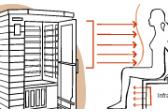
Far Infrared (FIR) saunas are relatively new – they don’t use steam, and instead rely on infra red radiation.

Far infrared (FIR) saunas are a relatively new type of sauna, and they work very differently to other types of sauna heaters. While conventional electric, gas and wood fired heaters all heat up the sauna using convection, FIR heaters use radiation heating. This means that instead of heating the air around you, the heater works directly on the body itself. This also means that FIR saunas are completely steam and stone free. FIR saunas are normally smaller than regular saunas, and some even consist of a small single person tent-like setup.
How do FIR sauna heaters work?
Far Infra-Red saunas work by emitting far infra-red light. Infra-red light is completely different to UV light, which has the potential to cause skin cancer. Although neither of these types of light is visible to the human eye, ultra-violet light has a shorter wavelength than visible light, while infra-red light has a longer wavelength.
Infrared light is also commonly known as infrafred radiation, and in itself is a type of radiant heat. FIR saunas work by emitting infrared radiation from heating panels, which is then absorbed directly by the human body, heating it from the inside so there is next to no heat lost in warming the air. Air temperatures are usually around 40-60°C in a FIR heater, as opposed to the standard sauna’s 60-90°C.
Practical differences between FIR and other saunas
The air temperature in an infrared sauna is much cooler and less humid than a traditional one, and this can make it a good option for those who find the air in a standard sauna too hot to breathe. Since the point of a sauna is to relax, being able to breathe easily is a significant issue for some people.

Different types of panel
An important consideration when you’re choosing an infrared sauna is the heater itself. Different materials are better at radiating infrared waves than others. The two common types of FIR emitters are carbon fibre emitters and ceramic emitters.
There’s a lot of noise and a tremendous amount of conflicting information published about both of these two types of heater by many different vested interests. Most sources agree, however, that if you go for a cheap option using either technology you’ll almost certainly end up with an inferior and inefficient product. Wherever possible, look for a reputable brand, and test several options before you buy.
Carbon fibre heaters are more expensive, but in theory can also be very efficient, provided that you buy the right technology. These panels normally emit radiation over a larger surface area, and are cooler to the touch as a result. The larger panels used by carbon fibre heaters are said to give a more even distribution of heat. Poor carbon fibre heaters often consist of only a thin layer of carbon fibre clad over a piece of plastic. Decent quality carbon fibre heaters (with greater than 80-90% conversion of energy into IR emissions) tend to be substantially more expensive.
Ceramic heaters are much cheaper, and come in a range of different types and styles, which vary greatly in terms of their effectiveness and efficiency. Ceramic heaters normally produce a more intense heat than carbon fibre FIR heaters in a smaller area, and heat up much faster. Different types of ceramic heaters perform very differently in terms of their efficiency.
Position and direction
Positioning of the heater panels is vital. Because the heat travels in a straight line, the FIR panels must be directed towards the body. Panels can be incorporated in the front, the back and on the sides of the bench with some also including panels for underneath the feet.
Health issues
For health reasons, many manufacturers warn against positioning panels at head height, as the heat can penetrate up to 3cm into the body. While some people might feel a little hesitant about exposing their bodies to FIR radiation, there’s little evidence to show that it causes any harm. FIR radiators are used to incubate premature babies, and most authorities agree that they are perfectly safe when used properly.
There are also many claims made about the health benefits of a FIR sauna over a regular sauna, although there’s very little in the way of critical scientific research on the topic.
|
Advantages
|
Disadvantages
|





